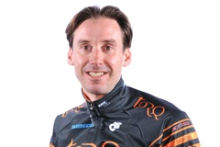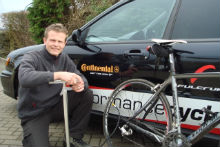Your first sportive of the year is only weeks away, but the festive season, and its excesses, are only a few weeks behind you.

Nutrition can be a complex subject, an area to which dietitians, nutritionists, performance coaches and a host of other specialists working in the field of sports science dedicate their attentions. We asked Matt Hart of Torq Fitness and Consultancy for his insights into the science of becoming a leaner, faster rider, while balancing the often conflicting demands of training goals with professional and family commitments.
Take a close look at the riders in the WorldTour peloton and you’ll notice a variety of different builds and body profiles: muscular sprinters, wiry climbers, and lean, powerful Classics specialists. “There are three somatotypes” says Hart, describing the physiological categories to which most of us can be ascribed.
“Ectomorphs typically are skinny and struggle to put on weight. Endomorphs are naturally more rounded and carry more body fat, while mesomorphs who are chiseled, Arnold Schwarzenegger types. Some people fit the category perfectly, others are a combination of a couple of categories.
“The best endurance athletes tend to be more ectomorphic. If you’re an endomorph, you have to work a bit harder. Weight loss doesn’t come as easy. You can never be an endomorph and look at a skinny guy and say, ‘I’m going to be like that’. You have to accept the body type you have, but there’s no excuse for 99 per cent of the population not to feel better by eating better.”
Eating to reduce weight and raise performance on the bike is very much a matter of balancing nutrient types. Hart says the two most important groups are carbohydrate and protein, with the cyclist’s scales tipped heavily in the direction of carbohydrate.

“All the research is showing that someone who is regularly active and wants to improve their performance should have a high carbohydrate diet. The more forward thinking research is looking at a total of 70 per cent carbohydrate, with 10 to 15 per cent of nutrients coming from protein. Lance Armstrong’s Tour diet was 67 per cent carbohydrate, and 13 per cent protein.”
Hart describes protein as “the most over-marketed supplement” and argues that a regular diet will provide sufficient protein for meat eaters, while vegetarians may have to include pulses and grains.
Fat is a vital source of vitamins A, D, E, and K and not something Hart says you should have to hunt for. The fate of every calorie not burned through exercise or work is to be stored as fat, he adds.
Having established that carbohydrate is the most important form of nutrition for an endurance athlete, which, by definition a sportive rider must be, we need to identify the most effective sources.
“If you assume your protein is covered by default, your main source of carbohydrate will be things like rice, pasta, and potatoes” says Hart. “People don’t realise that beans, chick peas, and lentils are not only a very good source of protein, but also very high in carbohydrates. If you’re going for a curry, and you can bare to leave the sauce, you can have double the amount of rice if you’re training the following day. That’s a good way of pushing up your carbs. If you’re doing a lot of exercise, you need to look at simple sugars as sources of carbohydrate. They’re a dense source of calories. By adding a dollop of honey to a slice of toast, you double the amount of carbohydrate, as well as making it easier to eat.”
High fat foods – deep fried, full-fat diary products for example – should, of course, be avoided, but Hart urges a realistic approach for the vast majority of us not earning a living as professional cyclists. “If you’re being really good with your nutrition and getting lean protein and carbohydrate, why not have a little treat in the evening? It depends on your level of focus. I don’t think you need to be perfect, but cut down on chocolate, cakes, dairy products, things that are oily or where the fat is hidden. We don’t tend to have an issue with drinks that contain sugar. If you have too many calories, you will store them as fat, but if you are exercising, a sugary drink can be a way of getting the carbohydrates you need.”
The challenge of weight reduction increases with the passing of time. “As you get older, you lose lean muscle mass, which will have a negative effect on metabolism, so you have to work harder to lose weight,” says Hart, “but it’s all relative. You could have someone in their fifties who’s fitter than they have ever been because they didn’t look after themselves when they were younger.”
The messages are encouraging: becoming leaner is an option for everyone, and its never too late to develop a fitness level that will put your younger, untrained self to shame. Understanding that there are recognised categories of body profile will help you set attainable goals.
Next week, we’ll look at the importance of fuelling for a ride: what to eat, when to eat it and how what you eat today will shape tomorrow’s ride.





